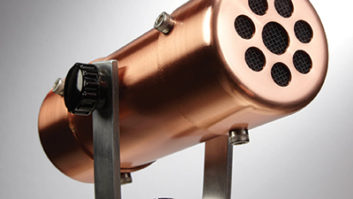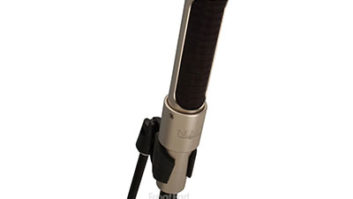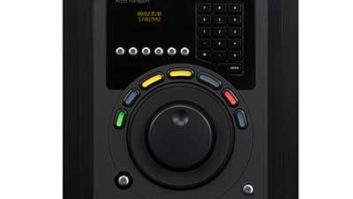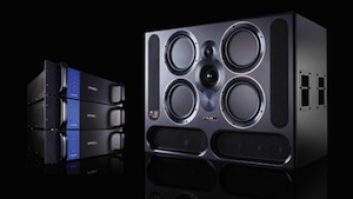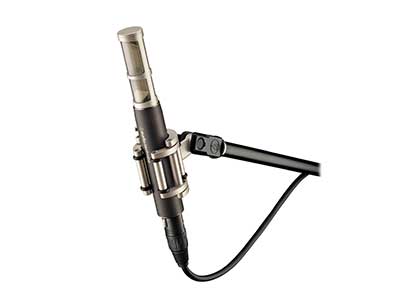
While rectangular capsules on mics aren’t new, they are relatively new to Audio-Technica. The company’s first product featuring this interesting design was the AT5040, which debuted in 2012 with four tightly spaced rectangular capsules in the same body. The fixed-cardioid AT5045 reviewed here sports a single rectangular capsule in an attractive, slender body.
There is no pad, roll-off, or much in the way of capsule protection, other than the thin metal grille at the top of the body and an included slide-on foam pop filter. The snap-in metal mic clip is the best design I’ve ever seen, clipping in and locking with a small metal toggle. Its position is variable up and down, and you can move the mic side to side within the mount. I had a pair of the 5045s (AT5045SP) for the review that came in a sturdy, custom foam-lined box that stored the mics, clips and foam filters.
So What’s Different?
A rectangular capsule offers features that, when done right, can correct inherent problems found in traditional capsule design. From my Pearl ELM-C review in the July 2005 issue of Mix: “The traditional circular capsule design carries a flaw: Its primary resonance can be sonically detrimental, especially when it resides in the audible range. Damping can help, but it does not eliminate the problem. Larger capsules improve signal-to-noise but add to the problem by lowering resonance further into the audible range.” So, a rectangular capsule reduces resonance while increasing surface area. It also offers exceptional rejection at the top and bottom of the mic, allowing you to keep cymbals, and other noisy neighbors out of your tight mic placements around a drum kit.
My first experience with the 5045 was on a tambourine overdub. It was a last-minute decision in the middle of a session. I had the mic in my car, so we put it up and gained it with a Neve 1073 preamp/EQ on the way to Pro Tools. Tambourines have a love/hate relationship with some mics. Some can’t handle the jangly transients and make the upper range sound clipped and unnatural. The 5045 sounded great right out of the box with no EQ added—exactly like a tambourine. On another session I put the 5045s over a drum kit with great results. The cymbals were well rendered at the high end while the kick, toms and snare were beefy with plenty of stick hit and body. Once again, minimal to no EQ was needed.
Because of the mic’s ability to handle hot transients, I wanted to try them up close on other drums—for starters, two Craviotto Maple toms. Side-address mics are always easier to place around drums because they can be nearly vertical, while pointing the top and bottom toward cymbals and the kick. This is where the high “rejectivity” (not a word, but I think I’ll coin it) of the 5045 helped to keep cymbals and other drums out of the tom tracks. While getting sounds, the output was so strong that I had to use an inline pad before the preamp to keep from overloading the input. After the pad was engaged, the mics gave no hint of breaking up no matter how hard the player hit. I added bit of 100 Hz, cut at 470 Hz, and then some high-midrange to bring out the stick hits. The EQ, new heads, and 5045s made the drums sound bigger than life in the mix. On another kit, I used the mics at the top and bottom of a classic Slingerland snare. Once again I used inline pads and fed the outputs to a pair of 1073 preamp/EQs. The snare sounded natural and sat right where it should in the mix.
The pair of 5045s sounded great on acoustic piano with the pair placed over the hammers and a third mic, an AKG D19, placed close to the soundboard inside the third hole from the tail. The 5045s were panned in stereo while the AKG was panned center and heavily compressed with an LA-2A. The 5045s sounded great by themselves, but adding the compressed D19 in the center brought up the body and presence of the piano. I cut the tracks without EQ.
At this point, being that the mic seemed to excel no matter where I put it, I placed one outside of a kick drum, with two other mics inside the drum on a pillow, and a Yamaha Subkick outside with the 5045. The Shure and Yamaha sounded as I expected, providing the beater definition and boom needed. The 5045 needed some EQ help, and while it provided some good tone, it would not be my first choice. Next I used the 5045 on a bass cabinet with great results. It handled the high output of the cabinet with ease and sounded great without EQ.
The AT5045 is a stellar microphone. Apart from the average results outside a kick drum, I could find no downside in any application. It sounded great on sometime-problematic hand percussion like tambourine, and shakers, which can sometimes seem strident through a condenser mic. On drum overheads, the overall sound of the kit was excellent, as were the cymbals. On acoustic piano, it captured the full range of the instrument and was bright without bringing too much unnatural shine to the top end. Like a great pair of ribbon mics, a sweet tube vocal mic, and stand-up, go-to dynamic microphones, the AT5045 is a new instant classic that should be in everyone’s mic locker. Get one (or two).
Kevin Becka is Mix’s technical editor.
TRY THIS
When recording acoustic guitar and vocal at the same time, position a pair of 5045s as you normally would on the guitar but angle them so the tops of both mics point at the singer’s mouth. The natural null point at the top of the rectangular capsule will greatly reduce the vocal leakage in the guitar mics. Using a more directional figure-8 condenser mic for the vocal and pointing the null point of the “8” at the instrument will keep the guitar out of the vocal mic.
Product Summary
COMPANY: Audio-Technica
PRODUCT: AT5045/AT5045SP
WEBSITE:audio-technica.com
PRICE: $1,399/$2,499
PROS: Sonically superior microphone. Easily handles high SPL. Great mic clip.
CONS: Not a great kick drum mic.
